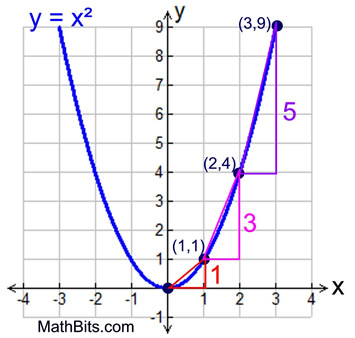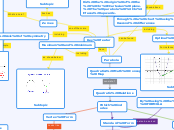Quadratics Math Concept Map
Quadratic Relations
Which includes
Vertex Form
y = a(x-h)² + k
The VERTEX(h,k)

Translations, which can be either
y = a(x-h)² + k , the h-value is the vertical translation
y = a(x-h)² + k , the k-value is the horizontal translation
a-value
The parabola will face downwards
The parabola will face upwards
Transformations
The parabola is compressed
The parabola is stretched
More specific on how much the parabola is being compressed or stretched, use the equation, "1a,3a,5a". Substitute the a-values into the equation, as shown below.

Standard Form
y = ax² + bx + c
complete the square if a=1
y = x² - 6x +4
y = (x² - 6x) +4
y = (x² - 6x + 9 - 9) +4
y = (x²- 6x + 9) - 9 + 4
y = (x-3)² - 5
The first blue Line is the standard form.The next line shows how the x variables are grouped. After grouping the x variables divide the middle coefficient by two, square the result, than add and subtract the number inside the brackets.Remove the subtracted term, from the brackets.Factor the brackets as a perfect square trinomial. Remember to solve whats outside the brackets as well. This is the result of factoring the standard form, which is now the vertex form.
complete the
square if a ≠1
y = 2x² - 16x -1
y = (2x² - 16x) - 1
y = 2(x² - 8x) - 1
y = 2(x²- 8x + 16 - 16) - 1
y = 2(x² - 8x + 16) - 16(2) - 1
y = 2(x - 4)² - 33
The first blue Line, is the standard form when a ≠1. Group the x-terms as shown in the red line. Common factor just the a-value from the x-terms. Divide the coefficient of the middle term by 2, square it,
then add and subtract that number inside the brackets. Remove the subtracted term from the brackets. Multiply it by the "a" value you factored out. Factor the brackets as a perfect square trinomial.
X-intercept/Factored Form
y = a(x-p)(x-q)
can also be changed into Standard form

You can complete the square.
Parabola
Key features
Zeroes

Subtopic
Zeros are
where a
parabola
cross the
x-axis. A
parabola
may have
one,two,
or no
zeros
Maximum and minimum

Subtopic
through a chart using second differences

Subtopic
Second differences, can assists with figuring our whether there is a linear relation, a quadratic relation, or neither.
y = x²
y = x² points to the coordinates
(0,0), which is the origin of the
Cartesian plane. The parabola
faces upwards.
Completing
the square
refers to
factoring a
perfect square
trinomial to get
the square
of a binomial
By using the QUADRATIC FORMULA

The Axis of symmetry

Optimal value

Subtopic
The optimal value
represents the
y-coordinate
The axis of symmetry
is a vertical line that
separates the parabola into
two congruent halves.

X-intercept /Factored Form
Floating topic

Vertex Form

Standard Form

